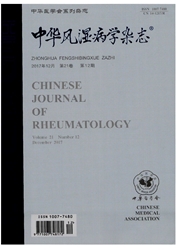

 中文摘要:
中文摘要:
目的研究B细胞在狼疮肾炎患者肾组织的浸润情况,探讨B细胞浸润与狼疮肾炎肾组织病理改变的关系及临床意义。方法收集119例处于活动期的狼疮肾炎患者肾组织标本。应用免疫酶组织化学方法检测肾组织中B细胞的浸润情况,根据浸润程度分为5级。统计分析采用两独立样本t检验和,检验。结果①119例狼疮肾炎中有B细胞浸润62例(52.1%),B细胞主要浸润于肾间质组织,多见于Ⅳ型狼疮肾炎患者,V型少见。②狼疮肾炎肾组织中B细胞浸润同无浸润组比较肾组织活动指数及慢性指数显著升高。差异有统计学意义;B细胞浸润组同无浸润组的血尿素氮水平比较[(12±9)与(6±3)mmol/L]、血清肌酐水平[(105±84)和(61±21)μmol/L](P〈0.01)。③狼疮肾炎肾组织中以IgG型抗体荧光强度最强;B细胞浸润组与无B细胞浸润组问各亚型抗体沉积率比较差异无统计学意义(P均〉0.05)。结论狼疮肾炎中伴有肾组织B细胞浸润的患者病变重于无B细胞浸润者,局部B细胞可能以非抗体生成细胞的方式参与狼疮肾炎病变。
 英文摘要:
英文摘要:
Objective To investigate B-cell distribution in lupus nephritis and evaluate its significance in pathological classification. Methods Kidney biopsy specimens were obtained consecutively from 119 patients with LN, B lymphocytes distribution were detected using immunohistochemical staining with specific antibodies and were classified into 5 groups. Chi-square test and t test were used for statistical analysis. Results ① B lymphocytes infiltration occurred in 52.1% of the LN patients (62/119), B lymphocytes were mainly distributed in the renal interstitial tissue, which occurred most frequently in class IV LN but rare in class V LN. ② B-cell infiltrating group was associated with active disease presentations and chronic indices P〈0.01 ). Blood urea nitrogen(BUN) [(12±9) vs (6±3) mmol/L] and serum creatinine(Cr) [(105±84) vs (61±21)μmol/Ll were higher in B-cell infiltrates group than non-B-cell infihration group (all P〈0.01 ). ③ Kidney biopsy specimens showed predominantly IgG deposit in immune-fluorescency intensity examination. The Ig subtype which deposited in B-cell infiltrating group was not statistically different from those deposited in uon-B cell infiltrating group (P〉0.05). Conclusion This study has shown that renal B cell infiltration occurs in 52. 1% of the LN patients. Patients with renal B cell infiltration have more severe kidney tissue injury and poorer renal outcomes than patients without B cell infiltration. Renal B lymphocytes infiltration may contribute to the pathogenesis of LN in a non-antibody-secreting way.
 同期刊论文项目
同期刊论文项目
 同项目期刊论文
同项目期刊论文
 Anti-class a scavenger receptor autoantibodies from systemic lupus erythematosus patients impair pha
Anti-class a scavenger receptor autoantibodies from systemic lupus erythematosus patients impair pha Anti-annexin II antibody is associated with thrombosis and/or pregnancy morbidity in antiphospholipi
Anti-annexin II antibody is associated with thrombosis and/or pregnancy morbidity in antiphospholipi Severe systemic lupus erythematosus in emergency department: a retrospective single-center study fro
Severe systemic lupus erythematosus in emergency department: a retrospective single-center study fro Association between anti-beta 2 glycoprotein I antibodies and renal glomerular C4d deposition in lup
Association between anti-beta 2 glycoprotein I antibodies and renal glomerular C4d deposition in lup Antiphospholipid antibody profiles in lupus nephritis with glomerular microthrombosis: a prospective
Antiphospholipid antibody profiles in lupus nephritis with glomerular microthrombosis: a prospective 期刊信息
期刊信息
